Kenwood KRF-V9993D, VR-4700, VR-4900 User Manual
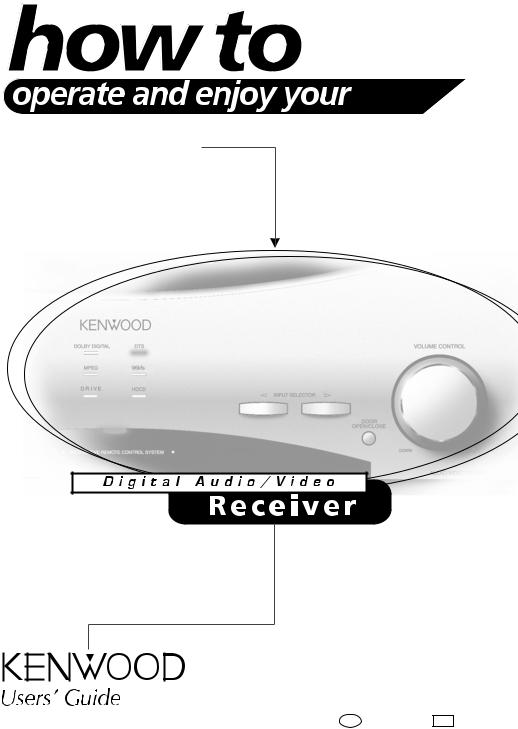
VR-4900/VR-4700 KRF-V9993D
B60-4660-10 01 CH (K, T, M, X) OC 9911

Using Your New Kenwood Audio-Video
Receiver
Welcome to the Users’ Guide for your new Kenwood Audio-Video Receiver. This manual covers three models:
The VR-4700 connects all your current audio and video components. It allows you to control them all with Kenwood’s remarkable PowerTouch touch screen remote—a graphical user interface without having to use your TV!
The VR-4900 and KRF-V9993D offers all the features of the VR-4700, and adds dual-room/dual-source operation, letting you play two different A/V sources independently in two different rooms! For a match made in “dual-room heaven,” add Kenwood’s dual-transport CD-2280M, CD3280M, DPF-J9010, DPF-J9020 or DPF-J9030 200-Disc CD Changer to the VR-4900 or KRF-V9993D.
NetFront® by Access Co., Ltd. is adopted for this product. Copyright© 1996, 1997 Access Co., Ltd.
NetFront® is registered trademark of Access Co.,Ltd. in Japan.
Table of Contents |
|
Chapter One: Moving Around ................................. |
1 |
What’s on the Front Panel of Your Kenwood Audio - Video |
|
Receiver? ................................................................................... |
2 |
What’s on PowerTouch? ........................................................... |
3 |
What’s on PowerTouch’s Screen? ............................................ |
4 |
The Quick Access Menu: ........................................................... |
4 |
How is PowerTouch Powered? ................................................. |
5 |
How Do I Use PowerTouch?..................................................... |
6 |
How Do I Move Around? ........................................................ |
7 |
How Do I Enter Text? ............................................................... |
8 |
Chapter Two: Using PowerTouch ............................ |
9 |
How Do I Adjust the Sound? ................................................. |
10 |
Turning the Speakers On ........................................................ |
10 |
Adjusting the Volume ............................................................. |
11 |
Adjusting the Loudness (Stereo mode Only) ....................... |
11 |
Adjusting the Tone (Front Left and Right Speakers Only) .. |
12 |
Adjusting Speaker Levels ....................................................... |
13 |
Muting Sound ........................................................................ |
15 |
Midnight Theater Function (Only Dolby Digital mode) .... |
16 |
To balance volume extremes: ................................................ |
16 |
What are Listen Modes?......................................................... |
17 |
Input Modes: ........................................................................... |
21 |
i
To Set the Input Mode manually: ......................................... |
22 |
To Set the Listen Mode manually: ........................................ |
23 |
Applying Digital Signal Processor (DSP) Effects ................. |
24 |
To set a DSP effect: ................................................................. |
25 |
HDCD and D.R.I.V.E. Effects ................................................ |
27 |
Headphone Operation .......................................................... |
28 |
How Do I Operate Devices? ................................................... |
29 |
Operating PowerTouch without Sending Commands to the |
|
Receiver(Operations using the SHIFT key): ..................... |
30 |
Movie Devices ......................................................................... |
31 |
TV ............................................................................................ |
32 |
VCR ......................................................................................... |
36 |
DVD Player ............................................................................. |
37 |
Laser Disc Player .................................................................... |
38 |
Music Devices ......................................................................... |
39 |
Kenwood 200-Disc CD Changer ........................................... |
39 |
Displaying Disc and Track Titles ........................................... |
40 |
Single or Rotary CD Player .................................................... |
45 |
CD-R Recorder ....................................................................... |
47 |
MD Recorder or Tape Deck ................................................... |
48 |
Turntable ................................................................................. |
51 |
Second CD Player or Tape Deck ............................................ |
51 |
Tuner ....................................................................................... |
52 |
How Do I Record (Edit Mode)? ............................................. |
59 |
Digital to Digital Recording: .................................................. |
61 |
Digital to Analog Recording: .................................................. |
61 |
ii
How Do I Adjust PowerTouch’s Display?............................... |
62 |
How Do I See PowerTouch in the Dark? .............................. |
62 |
How Do I See PowerTouch’s Screen More Clearly? ............. |
63 |
How Do I Turn the Beeping On or Off?............................... |
63 |
Using PowerTouch to Dim or Brighten the Receiver’s Front |
|
Panel ................................................................................... |
64 |
Changing the Front Panel Display Mode ............................. |
64 |
How Do I Perform Several Actions at Once? ......................... |
65 |
Creating Macros ..................................................................... |
66 |
Using Macros ........................................................................... |
70 |
How Do I Control Home Automation Equipment? .............. |
72 |
X-10 Home Automation ........................................................ |
72 |
Lutron ..................................................................................... |
74 |
Makita ..................................................................................... |
77 |
Accessories Control ................................................................ |
80 |
Chapter Three: Using PowerTouch in Multiple |
|
Rooms (VR-4900/KRF-V9993D) ............................ |
85 |
How Do I Switch Control Modes? ......................................... |
86 |
Why Don’t I See All My Devices?.......................................... |
87 |
How Do I Operate Devices? ................................................... |
88 |
Operating Devices in Room A .............................................. |
88 |
Operating Devices in Room B ............................................... |
88 |
iii
Chapter Four: Troubleshooting ............................. |
90 |
Sound...................................................................................... |
92 |
I don’t hear any sound at all ................................................. |
92 |
Audio is not output only when a 96k fs compatible disc is |
|
played. ................................................................................ |
92 |
I can’t hear sound from one or more of the speakers, or the |
|
sound is abnormally low .................................................. |
93 |
I can’t hear sound from my surround or center speakers ... |
93 |
I can hear sound only from the center speaker when Dolby |
|
Pro Logic or Dolby 3 Stereo is selected ............................ |
93 |
Sound from one (or more) of my devices is abnormally loud |
|
or soft ................................................................................. |
94 |
(VR-4900 and KRF-V9993D only) I can’t hear any sound in |
|
Room B ............................................................................... |
95 |
I can’t hear sound from some of my laser discs .................. |
95 |
There wasn’t any sound recorded on tapes made on my |
|
VCR or tape deck ............................................................... |
95 |
The initial sound is intermittent or non-existent when I start |
|
to play from a Dolby Digital,DTS or MPEG source ........ |
95 |
With a Dolby Digital program, the loud sounds aren’t very |
|
loud and the quiet sounds aren’t very quiet .................... |
96 |
All I hear is loud static when I play DTS discs ..................... |
96 |
I hear a hum when I select the PHONO input .................... |
96 |
Audio is not output only when a 96 kfs compatible disc is |
|
played. ................................................................................ |
96 |
Sound it intermittent ............................................................. |
96 |
Video ....................................................................................... |
96 |
I can’t see the program I’m playing on the TV |
|
There wasn’t any video output to my VCR when I |
|
recorded ............................................................................. |
96 |
iv
PowerTouch ............................................................................ |
97 |
I don’t see icons for all my devices ....................................... |
97 |
I don’t see icons for all the devices I set up ......................... |
97 |
When I select a device icon, I don’t see any |
|
commands ......................................................................... |
97 |
My PowerTouch is slow to respond—sometimes I have to |
|
press buttons or select commands several times ............ |
97 |
My PowerTouch is not responding ....................................... |
98 |
My PowerTouch is beeping. What does that mean? ............ |
98 |
PowerTouch does not "learn" new commands or functions |
|
............................................................................................ |
98 |
I want to clear all the items in PowerTouch and make it to |
|
the factory-set default condition ...................................... |
98 |
Receiver/Tuner ........................................................................ |
99 |
My receiver won’t turn on and the STANDBY indicator is |
|
flashing ............................................................................... |
99 |
The sound is distorted, and the CLIP indicator on the |
|
receiver’s front panel flashes red continually, or stays red |
|
for more than 1 second at a time .................................... |
101 |
I can’t access any RDS (Radio Data System) functions |
|
(VR-4900/KRF-V9993D) .................................................. |
102 |
I can’t receive a radio station ............................................... |
103 |
I’m getting a lot of static/interference ................................. |
103 |
When I press a key to tune to a preset station, the receiver |
|
does not respond .............................................................. |
103 |
Macro is not running as I programmed .............................. |
104 |
v
vi
What’s on PowerTouch?
Chapter One: Moving Around
Welcome to the Kenwood VR-4900/VR-4700/KRF-V9993D Users’ Guide. This chapter explains the keys and functions you can find on the front of the receiver and on the PowerTouch. The chapter also includes an explanation of how to navigate the convenient graphical display on your new PowerTouch.
It includes the following sections:
What’s on the Front Panel of Your Kenwood Audio - Video Receiver? page 2
What’s on PowerTouch? |
page 3 |
How is PowerTouch Powered? |
page 5 |
How Do I Use PowerTouch? |
page 8 |
1

Around |
What’s on PowerTouch? |
|
|
|
|
|
||
What’s on the Front Panel |
|
|
|
|||||
|
|
|
|
|||||
Moving |
of Your Kenwood Audio-Video Receiver? |
|
||||||
2 |
2 |
1 |
26 |
25 |
24 23 |
22™ 21 |
||
|
||||||||
|
A SPEAKERS B |
CD 2 / TAPE 2 |
|
|
MONITOR |
|
|
KRF-V9993D |
|
|
|
|
|
DOLBY DIGITAL |
DTS |
|
STANDBY |
MPEG |
96k fs |
|
POWER |
D.R.I.V.E. |
HDCD |
ON/STANDBY |
ON/STANDBY |
|
|
POWER
-ON –OFF
PHONES
Keys behind A SPEAKERS B |
INPUT CD 2/TAPE 2 LISTEN |
MULTI |
|
MODE MONITOR MODE SET UP SOUND |
fi CONTROL |
% fi P.CALL |
|
the door |
|
|
|
20
CLIP
INDICATOR PRO LOGIC 3 STEREO
¤ INPUT SELECTOR ‹
DOOR
OPEN/CLOSE
DOW
S VID
% MEMORY AUTO BAND
|
|
3 |
|
4 |
|
5 |
|
6 |
|
8 |
|
10 |
|
11 |
|
12 |
|
13 |
|
15 |
||
|
|
|
|
|
|
|
|
|
|
|
|
|
|
|
|
|
|
|
||||
|
|
|
|
|
|
|
7 |
|
9 |
|
|
|
|
|
14 |
|
||||||
1. |
STANDBY indicator light |
4. |
PHONES jack |
|
|
|
|
|
|
|
|
|
||||||||||
2. |
POWER ON/STANDBY key |
5. |
SPEAKERS A/B key |
|
|
|
|
|
|
|
||||||||||||
|
(VR-4900/VR-4700) |
6. |
INPUT MODE key |
|
|
|
|
|
|
|
||||||||||||
|
ON STANDBY key |
|
|
7. |
CD 2/TAPE 2 MONITOR key |
|
|
|||||||||||||||
|
(KRF-V9993D) |
|
|
8. |
LISTEN MODE key |
|
|
|
|
|
|
|
||||||||||
3. |
POWER ON / OFF switch |
9. |
SET UP key |
|
|
|
|
|
|
|
|
|
||||||||||
Standby mode
While the standby indicator of the unit is lit, a small amount of current is flowing into the unit’s internal circuitry to back up the memory. This condition is referred to as the standby mode of the unit. While the unit is in the standby mode, it can be turned ON from the remote control unit.
2
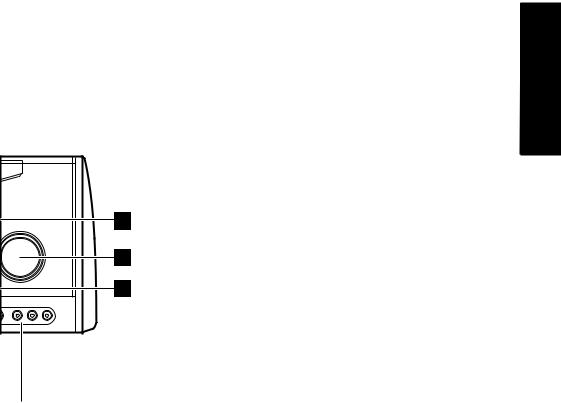
|
|
What’s on PowerTouch? |
||
|
|
|
10. |
SOUND key |
|
|
|
11. |
MULTI CONTROL (Up/Down) keys |
|
|
|
12. |
P. CALL (Up/Down) keys |
|
|
|
13. |
MEMORY key |
|
|
|
14. |
AUTO key |
|
|
|
15. |
BAND key |
|
|
|
16. |
AV-AUX input jacks |
|
|
19 |
17. |
DOOR OPEN/CLOSE key |
|
VOLUME CONTROL |
18. |
VOLUME CONTROL knob |
|
|
|
|
||
|
|
18 |
19. |
INPUT SELECTOR keys |
N |
UP |
17 |
20. |
Indicators |
|
|
|
CLIP INDICATOR |
|
O |
VIDEO L - AUDIO - R |
|
|
|
|
AV - AUX |
|
|
|
|
|
|
|
PRO LOGIC |
|
|
3 STEREO |
21. |
Indicators |
|
|
|
DTS / 96 k fs / HDCD |
|
|
|
16 |
|
DOLBY DIGITAL / MPEG |
|
|
D. R. I. V. E. |
22. |
DISPLAY |
|
23. |
2-way communication indicator |
|
24. |
Infrared remote sensor |
|
25. |
Indicators |
|
|
|
SPEAKER A/B |
|
|
CD 2/TAPE 2 MONITOR |
26. |
Infrared remote transmitter |
|
Keys 5 to 15 are located behind the door.
Around Moving
3

Moving Around
What’s on PowerTouch?
4
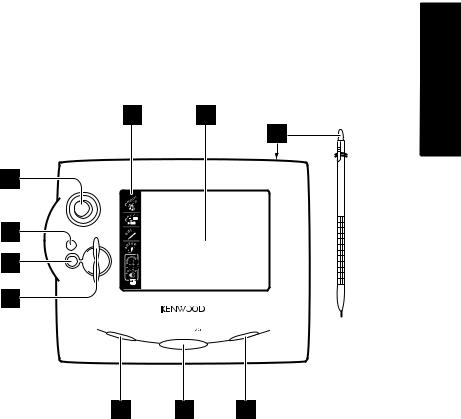
What’s on PowerTouch?
What’s on PowerTouch? (Touch Panel 2-way IR Remote)
|
|
|
|
|
|
8 |
|
9 |
|||
|
|
|
|
|
|
|
|
|
|
|
10 |
1 |
|
|
|
|
|
|
|
|
|
|
|
|
|
|
|
|
|
|
|
it |
|
|
|
|
|
|
|
|
|
e |
d |
|
|
|
|
|
|
|
|
|
|
|
|
|
|
|
|
|
ENTER |
|
|
o |
vi e |
|
|
||||
|
|
|
|
|
|
m |
|
|
|
|
|
|
|
|
|
|
|
|
|
|
|
|
|
2 |
|
|
|
|
|
|
u |
si c |
|
|
|
|
|
|
|
|
m |
|
|
|
|
||
CONFIRM |
|
|
|
|
|
|
|
|
|
||
|
|
|
UP |
|
|
n d |
|
|
|||
|
|
|
|
M |
|
o |
u |
|
|
|
|
|
|
|
|
E |
|
s |
|
|
|
|
|
|
|
O |
L |
U |
|
|
|
|
|
|
|
3 |
V |
|
|
|
|
|
|
o |
|
|
|
|
|
|
|
|
|
|
m de |
|
|
||
|
|
|
|
|
l |
|
|
|
|||
|
|
|
|
|
|
e |
n |
|
|
|
|
|
|
|
|
|
|
t |
|
|
|
|
|
|
|
|
|
|
|
s |
|
|
|
|
|
|
|
|
|
|
|
i |
|
|
|
|
|
|
MUTE |
|
|
|
|
|
a |
cr |
o |
|
|
|
DOWN |
|
m |
|
|
|
|
||||
|
|
|
|
|
|
|
|||||
4 |
|
|
|
|
|
|
|
|
|
|
|
|
|
|
|
|
|
CONTRAST |
|
SYS.POWER |
BACKLIGHT |
||
5 6 7
1.Joystick (see page 7)
2.Confirm button
3.Mute button (see page 15)
4.Volume up/down button (see page 11)
5.Contrast button
6.On/Standby button
7.Backlight button (see page 62)
8.Quick Access menu
9.Touch screen display
10.Stylus/Pen (stored on top edge)
Around Moving
3
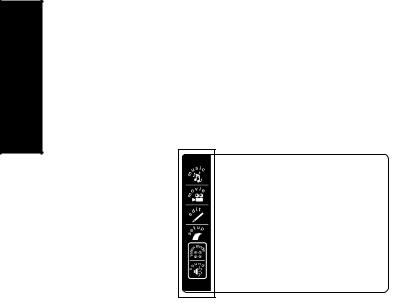
Around |
HowWhat’sis onPowerTouch?Powered ? |
|
What’s on PowerTouch’s Screen? |
||
PowerTouch’s LCD display screen is divided into two sections: the Quick |
||
Moving |
Access Menu and the Device Control/Menu Section. Use the stylus to |
|
touch the buttons in each area. |
||
|
Quick Access |
|
Device |
|
Control/Menu |
|
Menu |
|
|
|
Section |
|
|
|
PowerTouch also includes a QuickTour, which you can use to familiarize yourself with operating devices using the touch screen.
Touch  to familiarize yourself with operating devices using the touch screen. QuickTour provides a short narration for each major area that will automatically clear and move to the next topic. When it is finished it returns you to the main menu.
to familiarize yourself with operating devices using the touch screen. QuickTour provides a short narration for each major area that will automatically clear and move to the next topic. When it is finished it returns you to the main menu.
The Quick Access Menu:
The buttons in the Quick Access Menu are always available, regardless of what else is displayed on the touch screen. Touch these buttons for instant access to:
•Music device controls such as CD players or the radio tuner
•Movie device controls such as DVD players or VCRs
•Editing features
•Setup features
•Listen modes such as stereo, Dolby Digital or DTS
•Sound controls, such as loudness or “Midnight” mode
4

How is PowerTouch Powered ?
The Device Control/Menu Section: The device control section provides the same kinds of access as the Quick Access menu, but with more structure. Use the Main menu to navigate through the feature menus to exactly the feature or device you want to use.
Using these features, your Kenwood PowerTouch can store and display a large number of tasks, making it easier for you to access features. You get all the advantage of on-screen graphical display, without having to use a TV screen!
For more information on using these icons, see “How Do I Use PowerTouch?” on page 6.
How is PowerTouch Powered ?
Your new PowerTouch uses six AA (LR6) alkaline batteries and operates in the following range:
IR Sensor |
RF Remote Antenna |
|
(KRF-V9993D) |
||
(VR-4900, VR-4700) |
||
|
Around Moving
20 ft |
IR Transmitter |
|
(6m) |
||
|
e
If you use PowerTouch outside of this range, PowerTouch’s display may show incorrect information, or may not operate.
(VR-4900/VR-4700) : The remote control signal received by the main unit is only the RF signal.
The control distance of the RF remote signal is about 10 meters provided there is no obstacle.
(KRF-V9993D) : IR signals are transmitted and received.
5
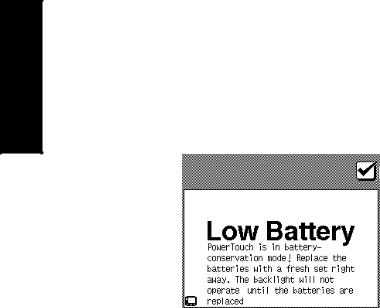
Around |
How isDoPowerTouchI Use PowerTouchwered? ? |
|
As you use PowerTouch, be aware of the following: |
||
|
||
Moving |
• When PowerTouch’s operating range gets shorter or PowerTouch dis- |
|
32 of the Connections and Setup Guide.) |
||
|
plays a low battery alarm, replace all 4 batteries (VR-4900, VR-4700) |
|
|
or 6 batteries (KRF-V9993D). (see “Installing the Batteries” on page |
•Do not install the receiver where direct sunlight or high-frequency fluorescent lighting can shine directly into the infrared remote sensor. This can limit PowerTouch’s operating range.
How Do I Use PowerTouch?
Use your new PowerTouch to control your new receiver and most devices attached to it. PowerTouch appears and functions a little differently from traditional remotes. Because it can control so many different devices, it displays a separate set of controls for each device on an LCD screen.
Only devices you have identified and connected to the receiver appear as buttons on the touch screen. If you are “missing” a device’s icon on the movies or music screen, make sure you have identified the device to the PowerTouch. For more information on identifying devices to the PowerTouch, see “Chapter Two: Setting Up PowerTouch” in the Connections and Setup Guide.
6

How Dois PowerTouchI Use PowerTouchwered? ?
Do not block the IR transmitter on the front panel of the receiver or on PowerTouch. Even a brief blockage while it is transmitting (such as someone walking by) can cause the communication and feedback to become erratic temporarily. If this happens, press CONFIRM and PowerTouch will resume normal operation (you might need to reenter the interrupted command).
How Do I Move Around?
1.Press any button or touch the screen to activate PowerTouch’s display.
2.Use the stylus to touch the menu or control button you want to use.
Operation using the joystick:
Use the joystick to adjust the contrast of the PowerTouch screen. For details, see “To adjust the contrast” on page 63.
Also use the joystick when using the OSD (On-Screen Display) of the DVD or LD player. (Certain functions may be restricted with some devices.)
•Display a menu containing the OSD function.
•Press the OSD button or Menu. The menu is displayed on the TV monitor screen.
•Select an item by tilting the joystick up/down or to the left/right.
•Press the joystick’s ENTER button to enter the selected item.
(With certain models, the selected item may also be established with the other buttons.)
Around Moving
7
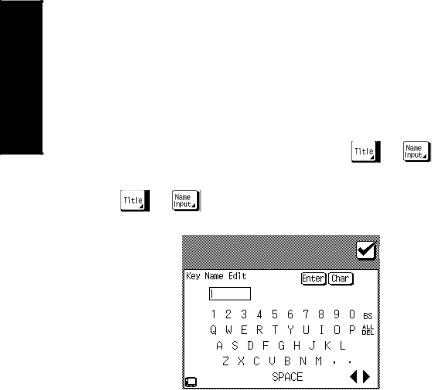
Around |
How isDoPowerTouchI Use PowerTouchwered? ? |
|
|
||
Many of the control menus allow you to assign your own names to list |
|||||
|
How Do I Enter Text? |
|
|
|
|
Moving |
items (such as radio stations, CD titles, etc.). |
|
|
||
To enter text for names: |
|
|
|
||
|
|
|
|
||
|
1. Access the control screen with the item name you want to change. |
||||
|
You have accessed the appropriate screen if |
or |
appears on |
||
|
the screen. |
|
|
|
|
|
2. Touch |
or |
: |
|
|
•Use the stylus to select characters from the keyboard.
•Touch  to access to lowercase characters. Touch it again to access special characters (such as @, !, &, etc.). Touch it a third time to return to uppercase characters.
to access to lowercase characters. Touch it again to access special characters (such as @, !, &, etc.). Touch it a third time to return to uppercase characters.
•Touch  or
or  to move back and forth between the characters.
to move back and forth between the characters.
•Touch  to clear the last character you entered. Touch
to clear the last character you entered. Touch  to delete all the characters in the line.
to delete all the characters in the line.
8

How Do I Adjust the Sound?
Chapter Two: Using PowerTouch
Your new receiver comes with the easiest—and most innovative— remote you’ve ever seen. Its palm-sized illuminated screen displays clear icons and menus. Because PowerTouch maintains two-way communication with your receiver, it shows the result of your action right on its screen.
PowerTouch is a universal remote that can control hundreds of devices, and is the first of its kind to offer infra-red compatibility with X-10, Lutron lighting, and Makita drapery control systems, making it perfect for controlling even the most elaborate home theater system. (VR-4900 and VR4700 only)
This chapter contains the following sections: |
|
|
How Do I Adjust the Sound? |
page |
10 |
How Do I Operate Devices? |
page |
29 |
Movie Devices |
page |
31 |
Music Devices |
page |
39 |
How Do I Record? (Edit Mode) |
page |
59 |
How Do I Adjust PowerTouch’s Display? |
page |
62 |
How Do I Perform Several Actions at Once? |
page |
65 |
How Do I Control Home Automation Equipment? |
page |
72 |
Receiver Using
9

How Do I Adjust the Sound?
How Do I Adjust the Sound?
You can control and adjust a variety of sound settings using the receiver’s front panel or PowerTouch.
Turning the Speakers On
To turn on the front A (Room A with the VR-4900/KRF-V9993D) speakers, press the DOOR OPEN/CLOSE key (VR-4900/KRF-V9993D) or press the lower part of the door (VR-4700) to open the door and press the SPEAKERS A key inside the door.
Speaker indicators
VR-4900/KRF-V9993D |
Using Receiver |
VR-4700 |
fi |
% |
fi |
% |
Speaker indicators
fi |
% |
fi |
% |
To turn on the front B (Room B with the VR-4900/KRF-V9993D) speakers, press the SPEAKERS B key located in the door of the receiver’s front panel. The lighting of a SPEAKERS (A or B) lamp indicates that the corresponding set of speakers is on.
VR-4900/KRF-V9993D: If you select SPEAKERS B (Room B) while listening to a surround mode in Room A, the sound in Room A will automatically revert to stereo. While SPEAKERS B is on surround made cannot be selected.
VR-4700: If you select SPEAKERS B while listening to a surround mode, the sound will automatically revert to stereo. While SPEAKERS B is on surround made cannot be selected.
If you use speakers connected to amplifiers via the PRE OUT jacks, choose Front A speakers.
10
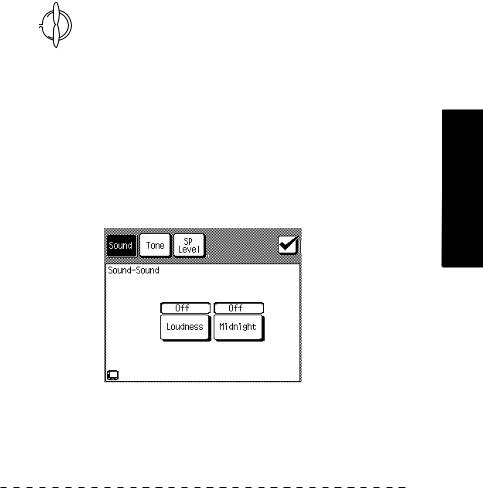
How Do I Adjust the Sound?
Adjusting the Volume
Use one of the following methods to adjust the volume.
•Turn the volume knob on the front panel of the receiver.
UP
|
|
|
E |
|
|
|
M |
|
O |
L |
U |
V |
|
||
|
|
||
|
|
|
•Press in the appropriate direction on PowerTouch.
DOWN
Adjusting the Loudness (Stereo mode Only)
The Loudness control increases the bass and treble at low volume control settings. This adjusts to the way the human ear hears sound at quiet volumes, retaining music’s fullness and sparkle.
1. Touch  (sound) on the Quick Access menu to open the Sound menu:
(sound) on the Quick Access menu to open the Sound menu:
If the opened menu is not the Sound menu, touch  .
.
2. Touch  to turn the loudness setting on or off.
to turn the loudness setting on or off.
3. Touch  to return to the previous menu or touch one of the Quick Access menu buttons to proceed to the next operation.
to return to the previous menu or touch one of the Quick Access menu buttons to proceed to the next operation.
Operation on the receiver:
1.Press the SOUND key inside the door repeatedly until LOUDNESS OFF or ON is displayed.
2.Press the MULTI CONTROL (%/fi) key to select LOUDNESS ON (or OFF), then press the SOUND key repeatedly until “SOUND FIXED” is displayed.
Receiver Using
11
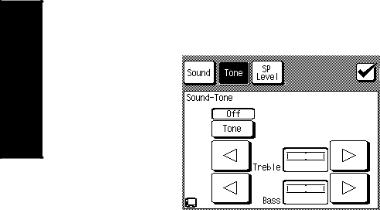
How Do I Adjust the Sound?
Adjusting the Tone (Front Left and Right Speakers Only)
Use the Sound menu to adjust the bass or treble tone of your front left and right speakers manually. In addition to setting bass and treble tone adjustment values, you can completely bypass the tone control circuitry for a purer sound.
Receiver Using |
1.Touch  (sound) on the Quick Access menu to open the Sound menu:
(sound) on the Quick Access menu to open the Sound menu:
2.Touch  to open the Tone menu:
to open the Tone menu:
12

How Do I Adjust the Sound?
3.Touch  to turn the tone settings on or off.
to turn the tone settings on or off.
4.If you selected “on” in the above, touch the left  or right
or right  arrow next to a tone setting (Treble or Bass) to adjust it. A readout
arrow next to a tone setting (Treble or Bass) to adjust it. A readout  between the arrows shows the current setting.
between the arrows shows the current setting.
5.Touch  to return to the previous menu or touch any Quick Access menu button to access that menu.
to return to the previous menu or touch any Quick Access menu button to access that menu.
Operation on the receiver: |
|
||
1. |
Press the SOUND key in the door repeatedly until TONE OFF or ON |
|
|
|
is displayed. |
Using |
|
2. |
Press the MULTI CONTROL (%/fi) key to display TONE ON (or OFF |
||
|
|||
|
if desired so). |
Receiver |
|
3. |
When ON is selected above and the SOUND key is pressed again, the |
||
|
|||
|
BASS setting menu appears. |
|
|
|
When OFF is selected above, the LOUDNESS setting menu appears. |
|
|
4. |
Adjust BASS level using the MULTI CONTROL (%/fi) key. |
|
|
5. |
Press the SOUND key. |
|
|
6. |
When the TREBLE setting menu appears, adjust the treble in the same |
|
|
|
way as above. To exit from setting, press the SOUND key repeatedly |
|
|
|
until “SOUND FIXED” is displayed. |
|
|
Adjusting Speaker Levels
You can use the Sound menu to temporarily adjust the speaker levels of your center speaker, surround speakers, and subwoofer. For example, if a particular movie has dialog that’s hard to understand, you can temporarily increase the center channel volume just for that movie. For more information on adjusting speaker levels permanently, see Chapter Two: Setting Up PowerTouch in the Connections and Setup Guide.
13
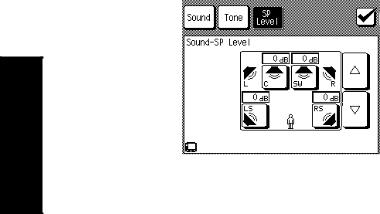
How Do I Adjust the Sound?
1.Touch  (sound) on the Quick Access menu to open the Sound menu:
(sound) on the Quick Access menu to open the Sound menu:
2.Touch  (Sp Level) to open the SP Level menu:
(Sp Level) to open the SP Level menu:
ReceiverUsing Although icons for the front speakers appear here, notice that they do not have buttons. They’re here for a visual reference; you cannot change their level.
3.Select a speaker by touching its button. You have selected a speaker when its button darkens.
The two surround speakers (LS and RS) cannot be adjusted independently between each other.
4.Touch the up  or down arrow
or down arrow  to adjust the volume of the speaker(s) you chose.
to adjust the volume of the speaker(s) you chose.
5.Touch  to return to the previous menu or touch any Quick Access menu button to access that menu.
to return to the previous menu or touch any Quick Access menu button to access that menu.
The subwoofer level can be adjusted between +10 dB and -20 dB, and other speaker level can be adjusted between +10 dB and -10 dB.
14

How Do I Adjust the Sound?
Operation on the receiver:
1.Press the SOUND key inside the door repeatedly until the name of the speaker(s) to be adjusted is displayed.
C : center speaker
LS/RS : surround speakers
SW : subwoofer
2.Press the MULTI CONTROL (%/fi) key to select the desired volume level, then press the SOUND key repeatedly until “SOUND FIXED” is displayed.
These settings automatically return to the level you adjust on Chapter Two of Connection and Setup Guide whenever you select a different source device or turn the receiver’s power off.
Muting Sound
Use one of the following methods to temporarily mute the sound:
•Press MUTE button on PowerTouch.
A “Mute On” message appears on the LCD screen for 3 seconds, then disappears. The MUTE indicator blinks during muting.
Use one of the following methods to cancel muting:
•Press either Mute button again.
•Adjust the volume control on either the receiver or PowerTouch.
A “Mute Off” message appears on the LCD screen for 3 seconds, then disappears.
The MUTE indicator on the receiver panel goes off.
Receiver Using
15

How Do I Adjust the Sound?
Midnight Theater Function (Only Dolby Digital mode)
Any time you don’t want to experience the loud and soft volume extremes of recorded sound (for example, late at night), use midnight Theater function to reduce volume extremes. This feature keeps loud, dramatic sound from being too loud (perhaps disturbing family members or neighbors) while ensuring that you can still hear whispered dialog or other soft sounds.
Midnight theater function only works if you are listening to a Dolby Digital program that has been encoded with special compression data.
To balance volume extremes:
|
1. Touch |
(sound) on the Quick Access menu to open the Sound |
|
|
|||
Using Receiver |
menu: |
|
|
If the opened menu is not the Sound menu, touch |
. |
||
|
|
|
|
|
|
|
|
2. |
Touch |
until the balancing sounds right to you: |
|
• OFF for normal balancing |
|
|
• 1 for quieter balancing |
|
|
• 2 for quietest balancing (the least difference between the loudest |
|
|
and quietest sound) |
|
3. |
Touch |
to return to the previous menu or touch one of the Quick |
Access menu buttons to proceed to the next operation.
16

How Do I Adjust the Sound?
Operation on the receiver:
1.Press the SOUND key in the panel door repeatedly until MIDNIGHT OFF, 1 or 2 is displayed.
2.Press the MULTI CONTROL (%/fi) key to select 1, 2 or OFF, then press the SOUND key repeatedly until returning to the previous menu.
What are Listen Modes?
You can experience true home-theater sound with your Kenwood AudioVideo Receiver. This receiver incorporates several listen modes to let you enjoy surround sound with a wide variety of program sources. Each produces multiple channels of surround-sound, but each does it differently.
• Stereo: Stereo listen mode provides standard stereo sound to the front |
Using |
|
left and right speakers. |
||
|
||
• Dolby 3 Stereo: Use Dolby 3 Stereo for systems that do not have |
Receiver |
|
surround speakers. When in the Dolby 3 Stereo mode, surround in- |
||
|
||
formation is redirected to the front left and right speakers. This mode |
|
|
is designed for use with Dolby Surround sources, but can also im- |
|
|
prove sound imaging and definition for programs that are not Dolby |
|
|
Surround encoded. |
|
|
• Dolby Pro Logic: Dolby Pro Logic is a decoding process which pro- |
|
|
vides theater-like surround sound from Dolby Surround encoded |
|
|
sources (such as videotape and LaserDisc software that are marked |
|
|
with the Dolby Surround logo). It offers excellent sound movement |
|
|
across the front of the room and a surround ambiance that seems to |
|
|
immerse you in a movie. Your receiver is equipped with a Dolby Pro |
|
|
Logic surround decoder to let you enjoy the wide variety of currently |
|
|
available Dolby Surround home video software. |
|
|
• DSP (Digital Signal Processing): DSP allows you to create your |
|
|
own custom surround sound environments and use them with any |
|
|
source (except Dolby Digital, MPEG and DTS). You can select the am- |
|
|
bience of an Arena, Jazz Club, Stadium, Cathedral or Theater, and |
|
|
then modify the parameters to ‘fine-tune’ the environment to your |
|
|
taste. (See “Applying Digital Signal Processor (DSP) Effects” on page 24 |
|
|
for details about making DSP adjustments.) |
|
17
|
How Do I Adjust the Sound? |
|
|
• MPEG: MPEG, which stands for “Moving Pictures Experts Group”, is |
|
|
an international standard of digital video and audio compression and |
|
|
decompression in media. It is the most efficient encoding method for |
|
|
compressed multi-channel audio which provides the highest sound |
|
|
quality to deliver the best movie theater sound into the home. |
|
|
• Dolby Digital: Dolby Digital uses an encode/decode process based |
|
|
on its theatrical digital surround sound technology. The five main |
|
|
channels are full-frequency and independent, so sound can completely |
|
|
envelop you or soar anywhere in the room, just like at the movies. |
|
|
Compared with Dolby Pro Logic, Dolby Digital has more clarity, |
|
|
greater surround envelopment, and more realistic sound movement |
|
Receiver |
between channels. |
|
Although a full set of speakers (front left and right, center, surround |
||
left and right, and a subwoofer) is required for true Dolby Digital |
||
surround sound, this receiver lets you enjoy Dolby Digital program |
||
Using |
||
sources, even if you connect fewer speakers. |
||
• DTS: DTS has five full-frequency channels that create effects nearly |
||
|
identical to those in a theater. Sounds seem to zoom from one place |
|
|
to another or entirely surround you. Like Dolby Digital, DTS has much- |
|
|
||
|
improved clarity, surround and sound movement capability compared |
|
|
with Dolby Pro Logic. This listen mode is available on CD, LD, and |
|
|
DVD media. DTS is a strictly digital format that can be supplied only |
|
|
by a CD, LD, or DVD player that supports DTS sound. If you attempt |
|
|
to listen to DTS encoded media through the analog connections to |
|
|
your new receiver, you will experience digital noise (loud static). |
18

How Do I Adjust the Sound?
You cannot select the Input Analog mode if you are playing DTS-en- coded media.
You cannot listen to DTS-encoded media in Room B. (VR-4900/KRF- V9993D only)
When playing DTS-encoded media, wait until “DTS” appears on the receiver display before proceeding.
The listen mode is fixed to Stereo during playback of 96k fs signals.
Your receiver can detect and switch between these formats automatically.
To check the Surround Play status:
1.Touch  (listen mode) on the Quick Access menu to open the Listen Mode menu:
(listen mode) on the Quick Access menu to open the Listen Mode menu:
Receiver Using
19

How Do I Adjust the Sound?
2.Touch  . This displays the Input Sound Status screen, which shows the signal being displayed.
. This displays the Input Sound Status screen, which shows the signal being displayed.
Receiver |
During Dolby Digital, MPEG or DTS playback, the program’s encoded |
|
|
||
Using |
channel configuration is shown using the L, C, R, LS, RS, S and LFE |
|
icons. |
|
|
|
|
|
3. |
Touch |
to return to the previous menu or touch one of the Quick |
|
Access menu buttons to proceed to the next operation. |
|
20
